Amelia Ashford
About the Author
Amelia Ashford is the founder and principal consultant at Ashford Numismatic Advisory, a New York City-based firm serving a clientele across the US and Europe. Despite being relatively young, she is an experienced numismatic advisor with 10+ years of experience advising collectors, museums, and private estates on high-value coins from different eras and cultural backgrounds. Historical coins are her favorites, for they bring stories trapped in the metal plates “that speak louder than words do.”

To become a specialist with immaculate expertise, Amelia earned her Master’s degree in Historic Art and Design at Sotheby’s Institute of Art. Staying close to auction processions, she learnt how to deal with the most outstanding items on the market and how to facilitate multimillion-dollar coin auctions successfully. No wonder did she turn to numismatic publications to share compelling insights, speak about the industry, and explain current market trends and coin valuations to a wide audience.
Meet Amelia Ashford with her latest research on the 1921 silver dollar value today.
Follow Amelia on Social Media



The 1921 Dollars at a Glance
History is passed through its relics, and each one is a quiet vessel carrying one back to the time of its creation. But relics differ in size, form, and the degree to which they have stories to tell. What would it be if not a coin with backgrounds condensed into the weight of ninety grains of silver?
Coins minted centuries ago are usually considered the most precious items on the market, as their circulation period has ended, and those who hold these pieces might have lost them for good. But which ones are worth keeping?
Among the coins minted in the 1920s, those struck in 1921 can probably be referred to as resonant. In fact, it was the only year in American history when two different silver dollar designs were released, i.e., the long-standing Morgan dollar and the debut of the inaugural Peace dollar. For numismatics, it was a precedent that defined the future of coins, as well as the collectibility potential of creations of 1921.
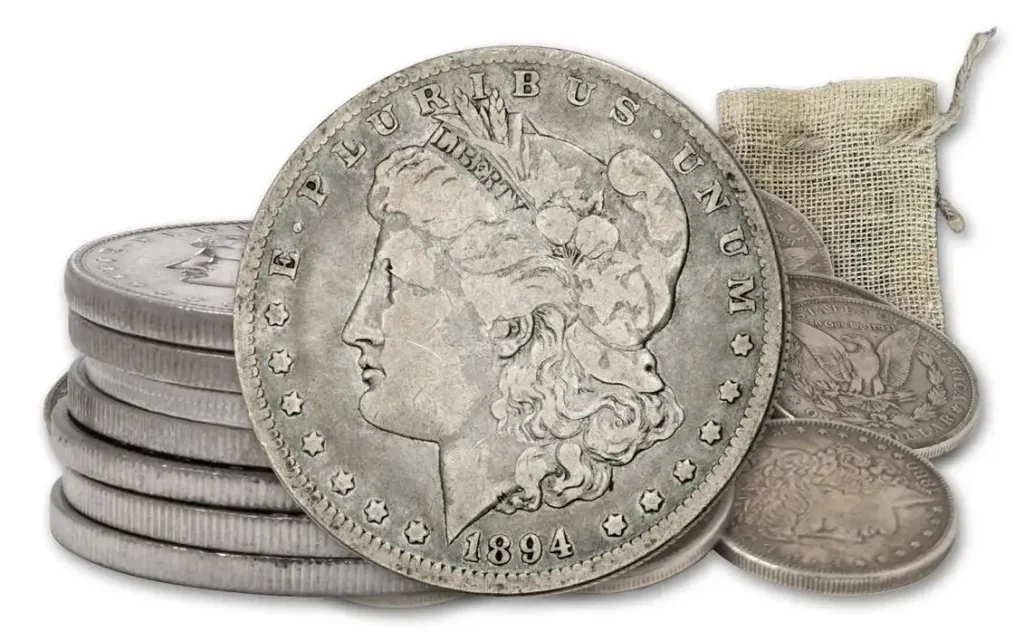
The History That Influenced the 1921 E Pluribus Unum Silver Dollar Value
The bygone times may send you gifts even when they get farther away. They shape the context and let them develop into something more sophisticated than just material objects with face value on them. The story of the silver dollar 1921 value is no exception.
The period of the early 1920s was transitional for countries all over the globe. Having been involved in World War I, each nation was to face consequences, i.e., exhaustion, but global relief. As for the US specifically, the postwar economy experienced inflation and a gradual yet dramatic shift from agrarian to industrial society. Even the least noticeable aspects were alternating.
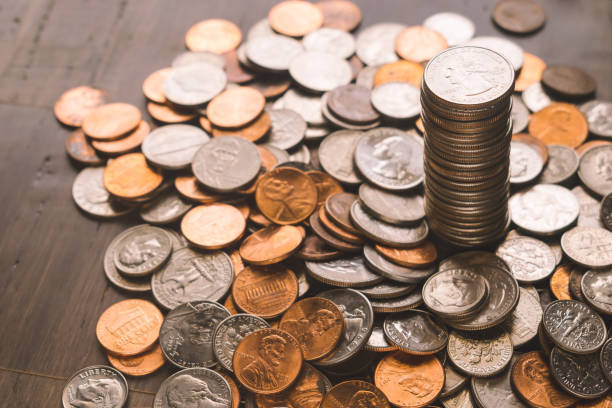
Coinage was also subject to change. In 1918, Congress passed the notorious Pittman Act, which forced the US Mint to melt down 350 million silver dollars to support their allies and stabilize the silver markets after the war. Nevertheless, by 1921, it was needed to recoin the melted silver, as the government urgently wanted to replenish what had been destroyed. This is how the Morgan Dollar, which had been a representation of power and national pride, was revived for one final year.
However, there was something else happening in the numismatic world. The war had ended in 1918, and the nation was also calling for symbols commemorating peace rather than hardships and recovery in the first place. Numismatists from different associations proposed the idea of paying tribute through new coins, which were soon released by the US Mint. Thus, 1921 became the first year of the Peace dollars series, i.e., a new chapter in the American monetary system.
Last but Not Least: Morgan Dollars
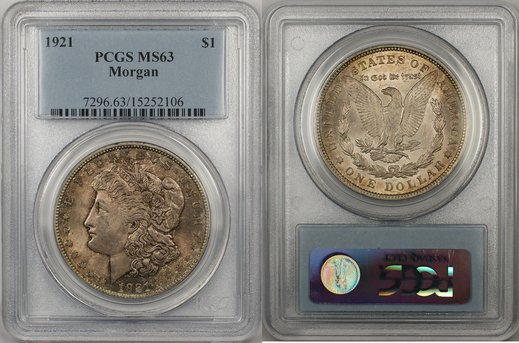
The 1921 Morgan silver dollar value has been strongly connected with its history, background, and appearance, not to mention. For collectors, the return of such an iconic series that once reflected the industrial ambitions of the nation was groundbreaking. Indeed, its reissue drew the attention of coin enthusiasts and opened collections for new instances to come.
The differences between earlier issues and the one minted in 1921 were rather subtle. Having destroyed the dollar dies in 1910, the US Mint had to recreate new hubs and dies from scratch. As a result, this led to minor design inconsistencies, including slightly lower relief details and a somewhat flatter overall appearance. Anyway, the core of these creations was the same, with the Morgan silver dollar value 1921 still growing as it did before.
Design and Physical Characteristics
Obverse: The obverse features a left-facing profile of Lady Liberty, designed after the model, Anna Willess Williams, a schoolteacher from Philadelphia. George T. Morgan, the creator of this design, strived to depict Liberty as an American woman, wearing a Phrygian cap, decorated with wheat and cotton. Along with the portrait, one may see the Latin motto “E Pluribus Unum” across the top, the date of mintage, and thirteen stars across the bottom.
Reverse: The reverse, on its part, shows a majestic eagle with its wings outstretched, clutching an olive branch and a bundle of arrows, all surrounded by a laurel wreath, along with the inscriptions “UNITED STATES OF AMERICA”, “IN GOD WE TRUST” and “ONE DOLLAR.”
| The Main Characteristics of the Morgan $1 | |
| Composition | 90% silver, 10% copper |
| Weight | 26.73 grams |
| Diameter | 38.10 mm (1.5 inches) |
| Thickness | 2.4 mm |
| Edge | Reeded |
| Designer | George T. Morgan |
| Mint Marks | No mark for Philadelphia “D” for Denver“S” for San Francisco |
Varieties of the 1921 Morgan $1 Coin
1921 $1 Morgan

Produced by: Philadelphia Mint
Mintage: 44,690,000
Auction Record: $19,975 for MS67
The Philadelphia issue is the most common of all three varieties, both in terms of total mintage and market availability. However abundant it can be, quality is a challenge. According to Q. David Bowers, almost all pieces were poorly struck, with soft detail and limited luster. However, there can be found three major designations: Mint State, Prooflike, and Deep Mirror Prooflike.
True mirror-proof specimens from this mint are overly rare, and the 1921 P Morgan silver dollar value may be high when authenticated.
1921-D $1
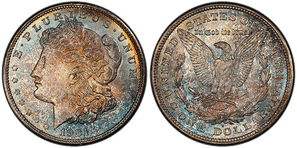
Produced by: Denver Mint
Mintage: 20,345,000
Auction Record: $50,400 for MS65
The 1921 D Morgan Dollar is a special creation, for it holds the status of the only Morgan ever struck at the Denver Mint. While it is generally of higher quality when compared to its Philly counterpart, high-grade specimens are far less common, which is obvious. What about the 1921 D Morgan silver dollar value? It will not disappoint you for sure!
1921-S $1
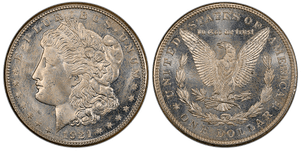
Produced by: San Francisco Mint
Mintage: 21,695,000
Auction Record: $19,200 for MS67
The San Francisco instance is notable for being scarce in circulation during the 1920s, as very few coins were released to the public at the time. As Q. David Bowers states in his “Silver Dollars & Trade Dollars of the United States: A Complete Encyclopedia”, many of these coins remained in storage for decades, and high-grade examples continue to appear in the modern market for the first time. This is why the 1921 S Morgan silver dollar value is always impressive.
Errors That May Be Worth Thousands
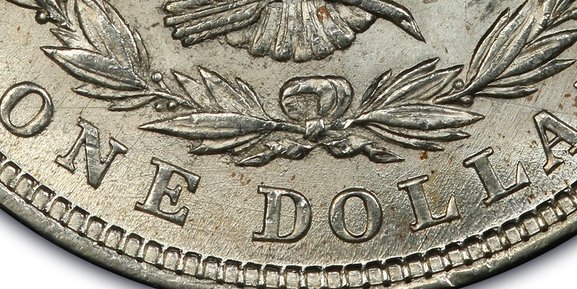
The place of origin and condition are essential constituents of the value of 1921 Morgan silver dollar. However, errors also matter. As for this particular numismatic creation, these are cataloged under the VAM (Van Allen–Mallis) system.
As an active auction consultant, I would like to point out two major varieties that may be found on the market and in private collections even today. These are VAM-1B – “Capped R” and Pitted Reverse. The first error is named for a distinct die break or “cap” over the “R” in the word “LIBERTY” on the obverse, while the second one refers to a rough, porous texture resembling tiny craters.
The First in the Series: Peace Dollars
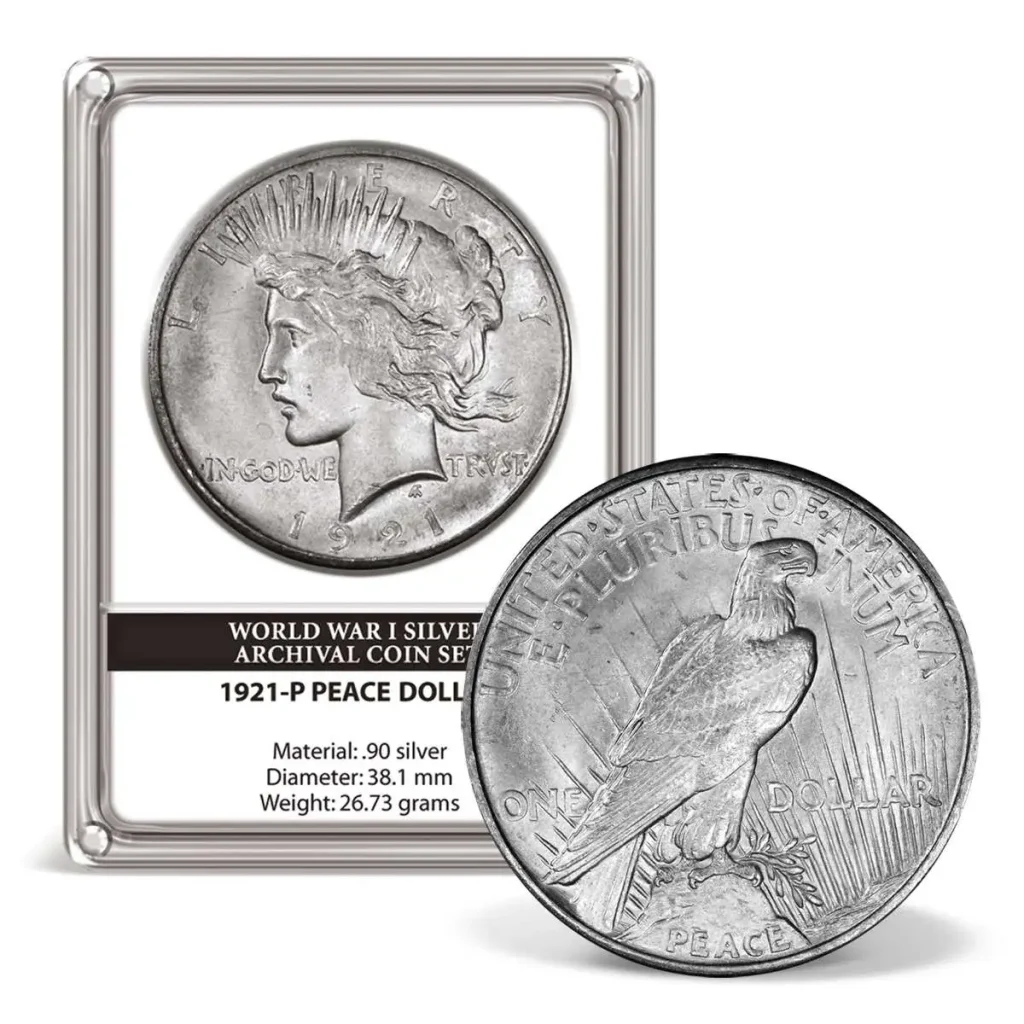
Issued by the end of 1921, the Peace dollar has entered the history of coinage and involuntarily shared its first chapter with the Morgan’s creation.
In broad terms, the coin was meant to become a symbol of post-war hope and the desire for lasting peace. Just like with other coins, there was announced the competition aimed at selecting the most appropriate design that would reflect the beauty and the most serene feelings possible. After intense discussions of promoted patterns, the Commission finally made its decision in favor of Anthony de Francisci’s design. But what is a 1921 silver dollar worth in this particular case?
Design and Physical Characteristics
Obverse: The obverse features Lady Liberty in left-facing profile, with her hair windswept, and a radiating crown on her head. Her facial features were modeled after de Francisci’s wife, Teresa, which gives it an intimate touch to the creation. Apart from the portrait, there are the inscriptions “LIBERTY” above her head, “IN GOD WE TRUST” split by her neckline, and the year below.
Reverse: The reverse demonstrates a majestic bald eagle sitting on a mountaintop and clutching an olive branch. Behind are rays of sunlight with the inscriptions “UNITED STATES OF AMERICA” and “E PLURIBUS UNUM” surrounding the eagle and words “ONE DOLLAR” and “PEACE” resting at the bottom.
| The Main Characteristics of the Peace $1 | |
| Composition | 90% silver, 10% copper |
| Weight | 26.73 grams |
| Diameter | 38.10 mm (1.5 inches) |
| Thickness | 2.4 mm |
| Edge | Reeded |
| Designer | Anthony de Francisci |
| Mint Marks | No mint mark for Philadelphia |
| Relief Type | High Relief (unique to 1921) |
Varieties of 1921 Peace $1 Coin
1921 $1 High Relief, Peace
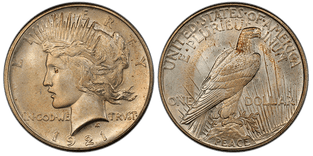
Produced by: Philadelphia Mint
Mintage: 1,006,473
Auction Record: $132,000 for MS67
David Hall once claimed: the 1921 $1 Peace coin was “one of America’s all-time classic coin issues.” Yes, indeed, it is a legendary coin, for it is the only Peace dollar struck in high relief, and the first of its kind. What is interesting is that this issue was initially not distinguished as a separate type of coin at first.
High-relief design was outstanding (they thought at first). In reality, such a design was quite difficult to produce properly, which is why it was instantly modified to a lower relief in 1922. As for the scarcity, the 1921 issue is the rarest in the series, especially in Mint State condition. Anyway, each instance is to be looked for, thanks to its history and possible growth of the 1921 peace silver dollar value in the future.
1921 $1 Peace, Satin Finish (Proof)
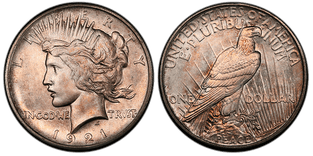
Produced by: Philadelphia Mint
Mintage: 8
Auction Record: $264,000 for PR66
The proof versions are considered the most valuable, for they are struck especially for collectors without any circulation period in their background. As for the issue, there were only 8 instances released, making it one of the rarest proof coins in American numismatic history. However, as one may assume, all the pieces are kept in reputable collections and will unlikely be sold to private collectors any time soon.
NB: The 1921 Lady Liberty silver dollar value may soon exceed millions of dollars, and this will be the turning point for the whole numismatic industry in the US.
Errors to Look For
When defining the 1921 Liberty silver dollar value, it is vital to understand that no one is immune to errors. Instead, they may boost the worth of a separate piece significantly. Among the most notable deviations registered by PCGS are VAM 1H – Polishing Lines, VAM 3 – Line Thru L, and VAM 1A – Reverse Field Break. The names themselves are self-explanatory and require no further definition. Other flaws are also possible, though they are usually less popular and, thus, not so expensive.
Why Do Collectors Emphasize the Great Value 1921 Silver Dollars?
The E Pluribus Unum 1921 silver dollar value has not always been so high as it is today (in fact, it was, but not so exaggerated). Indeed, the prices went up as soon as collectors understood the rarity, but when did it happen? It was all about the Silver Act of December 18, 1942, when the US government faced a critical need for silver to meet wartime needs.
As a response to this urgent demand, authorities had to melt down millions of silver dollars, with surviving items becoming a treasure in the hands of collectors. This intervention resulted in a significant reduction in the number of the above-mentioned coins in circulation, for they were the prime candidates for this fate. So, what is the value of a 1921 silver dollar? Significantly higher because of its tragic destiny.
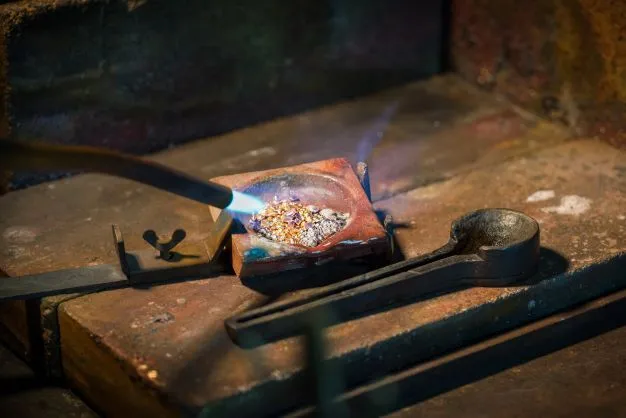
How Much Is a 1921 Silver Dollar Worth Today?
How much is a 1921 Morgan silver dollar worth? And is it higher than that of a Peace Dollar? Well, it depends on numerous factors like the condition of the instance, overall grade, the resource, market demand, and even current precious metals rates.
Nonetheless, one should be aware of average prices determined by agencies like PCGS and NGC for dealers to make fair purchases without getting scammed.
| Coin Type | Circulated | Uncirculated | MS64+ |
| 1921 Morgan Dollar (Regular) | $25 – $50 | $90 – $250+ | $600 – $25,500+ |
| 1921 Morgan Dollar (Prooflike) | $200 – $350 | $400 – $1,000+ | $1,450 – $23,000+ |
| 1921 Morgan Dollar (Deep Mirror Prooflike) | $300 – $1,400 | $1,500 – $12,500+ | $23,500 – $40,000+ |
| 1921 Peace Dollar (High Relief) | $160 – $1,000 | $1,200 – $1,750+ | $2,000 – $150,000+ |
| 1921 Peace Dollar (Satin Finish / Proof) | – | – | $350,000+ |
Note: Auction records are not necessarily representative of typical market value due to the human factors involved in bidding, such as auction timing, competition, and individual collector preferences. Auction prices do fluctuate and may not reflect consistent sale prices in regular markets. To stay up-to-date and know relevant pricing trends, always consult resources like Coin ID Scanner when evaluating the current worth of a coin.
The worth of each numismatic creation is a complex figure. To understand how much any coin may cost, one should learn more about its background and analyze its position on the global market. You might feel unsure at first. But fear not: understanding comes with learning, and through knowledge comes clarity.